ABSTRACT
In response to the growing importance of critical thinking, particularly in academic writing instruction, this study aims to thoroughly investigate a specific writing genre within the broader literature on critical thinking. Additionally, it seeks to identify research opportunities and validate scientific inquiry. Our research provides a comprehensive examination of critical thinking tendencies in academic writings spanning from 1989 to 2021, utilizing data sourced from Bibliometrix, a comprehensive bibliometric analysis tool. We assess bibliometric indicators by applying VOSviewer and Biblioshiny software to shed light on trends and patterns in critical thinking research. Our findings show a significant growth in research interest focused on critical thinking within academic literature over the past three decades, particularly in contentious issues. Moreover, analysis of keyword correlations, geographical distributions, and institutional affiliations suggests that Asian countries are at the forefront of critical thinking and argumentative writing research, with prominent affiliations dispersed throughout the region. By uncovering critical, cutting-edge research themes, this study equips future scholars and practitioners with valuable insights into the evolution of critical thinking inquiries, especially within academic writing contexts. Moreover, it paves the way for developing empirical projects and highlights potential practical implications for advancing critical thinking education in academic settings. This research contributes to a deeper understanding of the dynamics of critical thinking in academic discourse and underscores the need for continued scholarly attention to this crucial aspect of education.
INTRODUCTION
Developing arguments, both oral and written, is inextricably linked to the critical thinking process. Conceptualizing, reasoning, criticizing, innovating, contemplating, and problem-solving are all part of the process. Arguments become feckless to carry if the mentioned-process is not constructed. They will surely intertwine critical thinking with cognitive skill application and language development.[1–3] It becomes one of the most important assets or intellectual capital to have, as well as a vital component of individual maturation.[4] The issue of developing arguments and critical thinking in the context of EFL (English as a Foreign Language) and ESL (English as a Second Language) has been investigated for decades and has flourished from time to time, notably in the subject of producing argumentative writings. From the 1970s to the 1990s, the study on this topic was heavily focused on discussing the historical role of critical thinking in argumentative writing. The scope of the class instruction was then enlarged to include critical thinking in the curriculum tailored to assist language learners in writing and speaking arguments.[5–7]
After the 1990s, there was a noticeable trend in scholarly research focusing on argumentative writing and critical thinking. Researchers began to delve into critical thinking theories and explore how these theories could be applied to constructing influential argumentative texts. Many studies concentrated on implementing these theories into classroom instruction to enhance students’ ability to construct compelling arguments.[8–10] These studies typically involved training students in critical thinking skills and evaluating their argumentative texts to identify effective writing methods. Some recent studies aimed to develop models tailored to enrich students’ critical thinking and foster creativity in argumentative writing. One prominent model that emerged during this period is Toulmin’s model, which scholars such as Zainuddin extensively investigated for its effectiveness.[11] Toulmin’s model provides a framework for structuring arguments, emphasizing claims, evidence, and reasoning.[11] Zainuddin’s research focused on applying Toulmin’s model to teach argumentative writing, finding that it aided students in organizing and developing their writing effectively. In follow-up interviews, students expressed positive feedback, indicating that integrating Toulmin’s model improved their writing skills.
The research then grew into a larger topic,[12–14] encompassing various facets of argumentative literature and critical thinking. Throughout the time span, which extends from the initial studies to present day, research trends continue to lead to the implementation of Toulmin’s paradigm in creating argumentative literature. ‘Claim and support’ were involved. The paradigm has been widely used by researchers and has been determined to be effective in eliciting students’ reasoning abilities. Since 2010, research on critical thinking in argumentative text has explored a lot about the challenges encountered by language learners, as well as ideas to overcome critical thinking problems in argumentative learning, particularly in the last ten years.[15–21] As a result, there is an urge to integrate the trends in studies conducted by scholars around the world on the use of critical thinking, particularly in academic papers. Synthesizing the concise study themes on critical thinking and argumentation texts is valuable for assessing, categorizing, monitoring, communicating, anticipating, and researching future trends. For that purpose, bibliometric analysis provides a broad overview of trends and mapping of existing literatures, prolific authors, prominent journals, current subjects, and authors’ affiliations on a certain research topic.[22,23] Similarly, it provides comprehensive insights for study retrospective analysis, identifying areas of greatest need, quantitatively and objectively examining historical trends across many disciplines, and establishing relationships between researchers, theories, methods, and praxis across different scholarly disciplines.[23]
Although bibliometric mapping analysis has recently increased across multiple disciplines, such as science education, nursing, computer and technology etc.,[24–26] and some have also been conducted focusing on critical thinking and argumentation skills,[27–29] this study, on the other hand, attempts to dig into the research trend in critical thinking, one of the prominent educational issues, and relate it with a genre of writing, i.e., argumentative texts. By doing so, this study could draw a more accurate proportion of a specific writing genre to a large body of literature on critical thinking. Our research examines critical thinking tendencies in academic writing spanning from 1989 to 2021. This time span was chosen for several reasons. Firstly, starting from 1989 allows us to capture significant developments in the field of critical thinking and argumentative writing over the past three decades. During this time, there was a surge of interest in critical thinking education and its applications in various disciplines, including language learning and academic writing.
Furthermore, using 2021 as the endpoint allows us to include recent studies and trends in critical thinking research, ensuring that our analysis reflects the most up-to-date findings in the field. By extending our coverage until 2021, we can provide a comprehensive overview of the evolution of critical thinking tendencies in academic publications, including recent advancements and emerging topics. Moreover, this period coincides with the availability of relevant literature and data sources, allowing for a comprehensive bibliometric examination of research trends and patterns. By focusing on the period from 1989 to 2021, we aim to provide insights that are both comprehensive and current, enabling a deeper understanding of critical thinking in academic writings and its implications for educational practice. Therefore, the chosen time span of 1989 to 2021 allows us to perform a thorough analysis of critical thinking tendencies in academic writings, considering historical developments, recent trends, and future directions in the field.
Furthermore, several factors influenced our decision to conclude our study in 2021 rather than extending it into 2022 and 2023. First, trustworthy restrictions on resource availability became apparent. Further, due to publication constraints in academic research, works from 2022 to 2023 may have yet to be widely disseminated or indexed in databases when we did our analysis. By focusing on data up to 2021, we intended to assure the quality and trustworthiness of our conclusions while maintaining a manageable scope for the study. While integrating more recent years could provide a more complete picture of recent trends, the choice was made to balance the requirement for current information and the possibility of completing a detailed study within the project’s constraints.
Thus far, the study approach and analysis have been time-consuming and costly, especially in critical thinking in argumentative texts. As a consequence, the bibliometric is worthwhile to arise in order to examine underdeveloped matters. Based on the findings of the analysis, the report provides conclusions and recommendations. As it implies, the present study is an initial endeavor to do a bibliometric investigation on the topic, with three primary research objectives.
Topic Trends and Productivity: to know the annual scientific production of critical thinking in argumentative texts articles from 1989 to 2021, to investigate the social structure in term of three-fields plot based on keywords-countries-and affiliations of critical thinking in argumentative texts articles from 1989 to 2021, to identify the topic trends of critical thinking in argumentative texts articles from 1989 to 2021, and to investigate the conceptual structure in term co-occurrence of keywords of critical thinking in argumentative texts articles from 1989 to 2021.
Citations: to know the average citation per year of critical thinking in argumentative texts articles from 1989 to 2021, to identify the top cited articles critical thinking in argumentative texts from 1989 to 2021, to identify the scholarly configuration of co-citation network and historiography analysis of critical thinking in argumentative texts articles from 1989 to 2021, to identify the academic journals publish articles related to critical thinking in argumentative texts from 1989 to 2021.
Authorship: to know the most prolific authors of critical thinking in argumentative texts articles from 1989 to 2021, to know the most cited authors of critical thinking in argumentative texts articles from 1989 to 2021, to know the most impacting authors of critical thinking in argumentative texts articles from 1989 to 2021, to know the most productive affiliations publishing critical thinking in argumentative texts articles from 1989 to 2021, to know the most productive countries contributing critical thinking in argumentative texts articles from 1989 to 2021, and to investigate co-authorships of critical thinking in argumentative texts articles from 1989 to 2021
METHODOLOGY
Research Design
One of the most critical choices scholars make when designing a study is determining the period or considering the subdivision of periods. In our study, from 1989 to 2021, we have chosen a substantial time frame to capture the evolution of critical thinking trends. Although breaking down the analysis into different periods might show changes in the discipline over time, our subsequent sections lacked a disciplined division of eras for evaluation. It has implications for future studies in the same areas by incorporating temporal divides into the study to provide more specific insights into the evolution of critical thinking research and its connection with argumentative writing at various phases of academic investigation. However, by spanning a substantial period, we could identify nuanced shifts, emerging patterns, and research interests or methodology moves across different time frames, improving our understanding of the field’s development. A bibliometric configuring approach was used to examine quantitative and qualitative texts indexed in the Scopus database.
Literature Search and Data Collection
In searching and collecting the data, we adopted Aria and Cuccurullo’s[30] steps. The steps were divided into three stages. The first step was to get the data. It was accepted that numerous online bibliographic databases store metadata for scientific works. Scopus is a bibliographic database (http://www.scopus.com). Scopus is a monitored repository, indicating that data has been meticulously selected for inclusion. Editors and publishers provide manuscripts for consideration for inclusion in Scopus, which is reviewed and chosen based on scientific credibility and accuracy criteria. This ensures that only handpicked, high-quality information is indexed.[31]
On October 25, 2021, first, we started by searching the Scopus database for documents. The term being searched comprises compound terms concatenated with the OR operator. The first search field contained the keywords “critical thinking skill” to search “all fields.” In contrast, the second search field contained keywords such as critical thinking, critical thinking and writing, argumentative writing, argumentative essay, argumentation, English language teaching, English teaching, teaching English, English as a second language, English as a foreign language, English language learning, English learning, English education, English language education. The search string includes: ((“critical thinking skill*” OR “Critical Thinking” OR “critical thinking and writing”) AND (“argumentative writing” OR “argumentative essay*” OR “argumentation”) AND (“english language teaching” OR “english teaching” OR “teaching english as” OR “english as a second language” OR “english as a foreign language” OR “english language learning” OR “english learning” OR “english education” OR “english language education”)) AND (LIMIT-TO (PUBSTAGE, “final”)) AND (LIMIT-TO (DOCTYPE, “ar”)) AND ( LIMIT-TO (LANGUAGE, “English”)) AND (LIMIT-TO ( SRCTYPE, “j”)).
The second step was loading and converting the data. The data was collected from the Scopus database and loaded into the Java programs VOSviewer and Biblioshiny. VOSviewer demonstrated a robust visualization software created primarily for bibliometric analyses. It excelled at creating and visualizing networks of authors, keywords, or concepts based on co-occurrence or co-citation associations. On the other hand, Biblioshiny, an R-based bibliometric analysis tool, gave us a wide range of capabilities, including data cleaning, processing, and analysis, all within the R environment.
The use of both VOSviewer and Biblioshiny provided several advantages. VOSviewer’s effective visualization capabilities enabled the generation of meaningful network maps, allowing us to visually investigate the interactions between various aspects of the dataset. Meanwhile, Biblioshiny’s comprehensive suite of bibliometric analysis tools ensured that our data was thoroughly processed and validated, including sorting and proofreading key metrics such as publication numbers, author affiliations, citation counts, and publication dates. By including VOSviewer and Biblioshiny in the workflow, we could enhance the scope and reliability of our bibliometric analyses. VOSviewer offered us intuitive visuals that gave us a comprehensive view of the information, and Biblioshiny’s analytical capabilities allowed for rigorous data validation and in-depth statistical analysis. Together, these software tools enabled us to perform a complete evaluation of the bibliometric data, providing informed insights into publishing trends, author partnerships, and research impact in the field.
Using the VOSviewer and Biblioshiny software, all of the information needed for the analysis was produced into CSV and RIS files. These files contained bibliographic metadata from the Scopus database, including article titles, authors, affiliations, publication years, keywords, and citation counts. The data could be loaded into spreadsheet applications for preliminary data exploration and editing by creating CSV files. Meanwhile, RIS files enabled the export of bibliographic entries in a consistent format, enabling compatibility with analysis programs such as VOSviewer and Biblioshiny. Employing both CSV and RIS files helped the study process and the analysis and visualization of bibliometric data more efficiently.
Further, we sorted and proofread the data as follows: number of publications, nations, journals, and researchers or authors, keywords, areas of greatest need, overall citations, average publication year, and institution sources. The last step was to sanitize the data. Multiple versions of the same publication and different spellings of the author’s name could be found in cited sources. Books had different editions, which could appear as different citations. Common names could also arise because authors were typically abbreviated by their surname and initials. Several preprocessing methods could be applied to detect duplicate and misspelled elements. The summary and details linked to critical thinking in argumentative texts publications are shown in Table 1 to provide an overview of the data.
| Description | Results |
|---|---|
| Main Information about Data | |
| Timespan | 1989:2021 |
| Sources (Journals, Books, etc.,) | 157 |
| Documents | 257 |
| Average years from publication | 3,51 |
| Average citations per documents | 6,848 |
| Average citations per year per doc | 1,378 |
| References | 15739 |
| Document types | |
| Article | 257 |
| Document contents | |
| Keywords Plus (ID) | 243 |
| Author’s Keywords (DE) | 854 |
| Authors | |
| Authors | 585 |
| Author Appearances | 630 |
| Authors of single-authored documents | 65 |
| Authors of multi-authored documents | 520 |
| Authors Collaboration | |
| Single-authored documents | 68 |
| Documents per Author | 0,439 |
| Authors per Document | 2,28 |
| Co-Authors per Documents | 2,45 |
| Collaboration Index | 2,75 |
Data Analysis
The analysis was conducted by utilizing the data available in the Scopus database. The collected data was automatically resulted from the year 1989 to 2021. The search retrieved 257 documents of Scopus records from the total 15.739 references, and the documents types is article. The average years from publication is 3.51. The median number of citations per document is 6.8, and the median per year is 1.37. Then in related to the authorship, the total authors is 585. There are 65 people who solely published the document and there are 520 authors of multi-authored documents. In addition, the data cumulatively had 2.75 collaboration index.
The metadata of critical thinking in argumentative texts was exported from the Scopus database, both CSV and RIS files, and they were named critical_argumentative_scopus.csv and critical_argumentative_scopus.ris and format for later analysis. For data analysis, we employed VOSviewer software and Biblioshiny software to perform a comprehensive science mapping analysis.[30] The Biblioshiny was used to analyze the data related to critical thinking in argumentative texts articles from 1989 to 2021 to know the annual scientific production, the three-fields plot based on keywords-countries-and affiliations, the average citation per year, the most prolific authors, the most frequently referenced authors, the most impacting authors, the best-performing affiliations, the most productive countries, the top cited articles, the intellectual structure in terms of co-citation network and historiography analysis, the topic trends, and the academic journals. While VOSviewer application was employed to evaluate the data linked to co-occurrence of keywords and co-authorships.
We learned that while Bibliometrics is a popular R program for bibliometric analysis, we used VOSviewer and Biblioshiny for various reasons. VOSviewer is well-known for its extensive visualization capabilities, particularly the ability to build and visualize networks of authors, keywords, or concepts based on co-occurrence or co-citation associations. This was thought necessary for investigating the dataset’s linkages and trends, such as the coexistence of keywords and co-authorships. Biblioshiny, an R-based bibliometric analysis tool, provides various features such as data cleaning, processing, and analysis within the R environment. It was chosen for its capacity to give extensive analysis, including annual scientific production, a three-field plot based on keywords, nations, and affiliations, average citation per year, prolific authors, impactful affiliations, productive countries, and top cited papers. While Bibliometrix can do bibliometric analysis, VOSviewer and Biblioshiny were chosen to ensure a complete examination of the dataset. They were used to optimize the depth and breadth of the bibliometric assessment performed in the study.
Findings
The current study focuses on analyzing publications describing critical thinking in argumentative writings from 1989 to 2021, with the research aims outlining the goals of the research. The research findings are shown in detail in the order of the research objectives.
Topic Trends and Productivity
To attain the first study goal of displaying the annual scientific publication of publications on critical thinking in argumentative texts from 1989 to 2021. The data were processed in the Dataset bar after being loaded into Biblioshiny software, and the analysis is shown in Figure 1.

Figure 1:
Annual scientific publication.
Figure 1 depicts the gradual increase in annual scientific publishing of critical thinking in argumentative text articles from 1989 to 2021. To be more specific, the sheer number of publications associated to critical thinking in argumentative texts was still modest from the beginning until 2007, with 1 article published annually and 2 articles published in Scopus in 1997. From 2009 to 2013, publications gradually increased from 4 to 6 pieces. The year with the most publications is 2020, while the year with the second most publications is 2021, with 59 and 52, respectively. A further finding is regarding the social structure in terms of three-field plot based on keywords-countries-and affiliations of critical thinking in argumentative textual articles from 1989 to 2021. Figure 2 depicts a three-field plot from the Biblioshiny software based on keywords, nations, and affiliations.
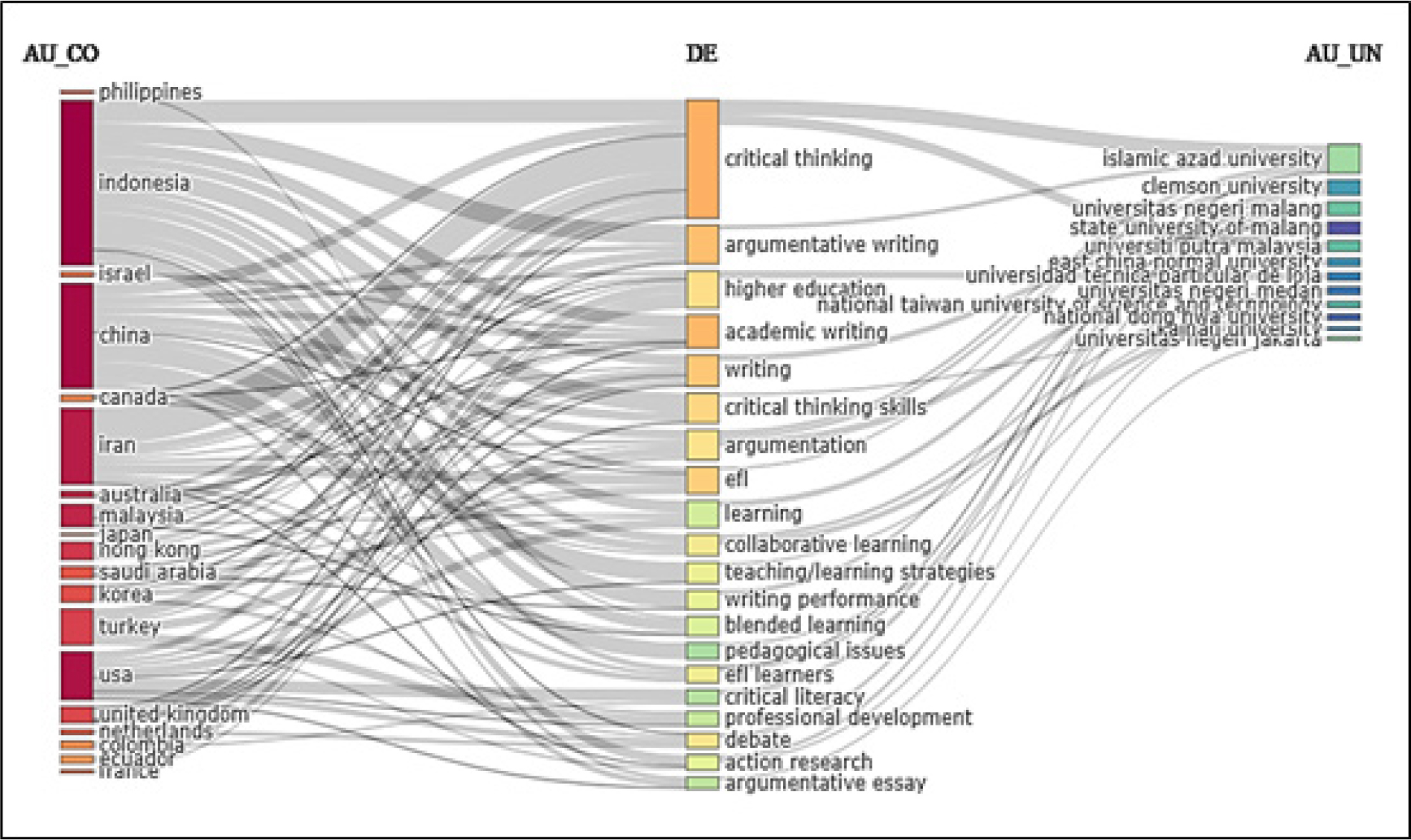
Figure 2:
Tree-fields plot (middle-field is keywords; left-field is countries; right-field is affiliations).
Figure 2 illustrates a three-field Graph (Sankey diagram) of authors, affiliations, and article keywords of the referred sources, which was designed to show the ratio of research topics for each country as well as the affiliations of the publications that they mentioned. Critical thinking and argumentative writing are the key interests of critical thinking in argumentative texts scholars in Indonesia, as illustrated in Figure 2. Furthermore, the major research topics in China and Iran include critical thinking and argumentative writing. The majority of the articles that covered higher education were published in the United Kingdom, the Netherlands, Colombia, Ecuador, and France. Surprisingly, despite the fact that critical thinking and argumentative writing are prominent terms in Indonesia, scholars affiliated with Universitas Negeri Malang are interested in writing performance, EFL learners, and action research.
Furthermore, we used Biblioshiny software to do further investigation on the topic trends of critical thinking in argumentative text articles from 1989 to 2021, with the following approach settings set: We establish the title field, the N-Grams, the Bigrams, and the word stemming. Figure 3 depicts the subject trends based on the Bibliohiny study.
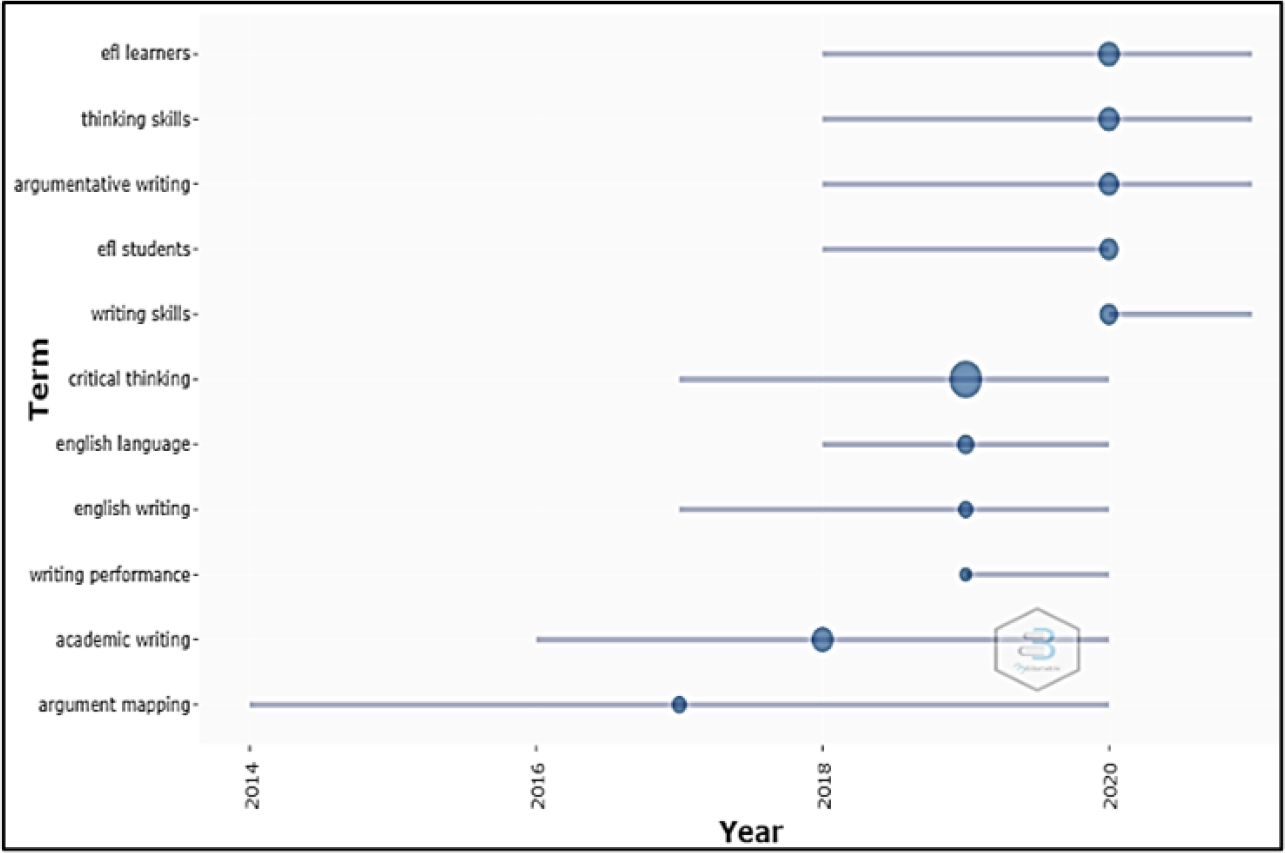
Figure 3:
The trends topic.
As shown in Figure 3, the topic argument mapping was popular in 2017 and was followed by the topic academic writing in 2018. While the top trends in 2019 include writing performance, English writing, English language, and critical thinking, they are changing in 2019. Writing skills, argumentative writing, thinking skills, and EFL students/learners are the trends topics for 2020, as opposed to 2017, 2018, and 2019. Table 2 details the total frequency of the trends topic.
| Items | Frequency | Year_q1 | Year med | Year_q3 |
|---|---|---|---|---|
| Critical thinking | 56 | 2017 | 2019 | 2020 |
| Academic writing | 17 | 2016 | 2018 | 2020 |
| EFL learners | 16 | 2018 | 2020 | 2021 |
| Thinking skills | 15 | 2018 | 2020 | 2021 |
| Argumentative writing | 13 | 2018 | 2020 | 2021 |
| EFL students | 11 | 2018 | 2020 | 2020 |
| Writing skills | 10 | 2020 | 2020 | 2021 |
| English language | 8 | 2018 | 2019 | 2020 |
| Argument mapping | 6 | 2014 | 2017 | 2020 |
| English writing | 6 | 2017 | 2019 | 2020 |
| Writing performance | 5 | 2019 | 2019 | 2020 |
Table 2 shows that among the most commonly used topics by authors was critical thinking (56) from 2017 to 2020. Academic writing is the second most frequently used topic by the authors, with 17 uses from 2016 to 2020, while EFL learners is the third most frequently used topic by the authors, with 16 uses from 2018 to 2021. Surprisingly, the current trend topics in 2021 include writing skills, argumentative writing, thinking skills, and EFL learners, whereas critical thinking is not now in vogue.
Furthermore, we used VOSviewer software to investigate the conceptual structure in terms of co-occurrence of keywords of critical thinking in argumentative text articles from 1989 to 2021. We began by selecting relationship as the kind of data to examine and “author keywords” as the component of investigation. Then there were 851 keywords, and 13 of them met the criterion when we allowed for the smallest degree of keyword recurrence (5). A relevancy score was determined for each of the 13 terms. The most relevant terms were chosen based on their score. Eleven words were discovered. Figure 4 shows a detailed map and information about the co-occurrence of critical thinking terms in argumentative texts.
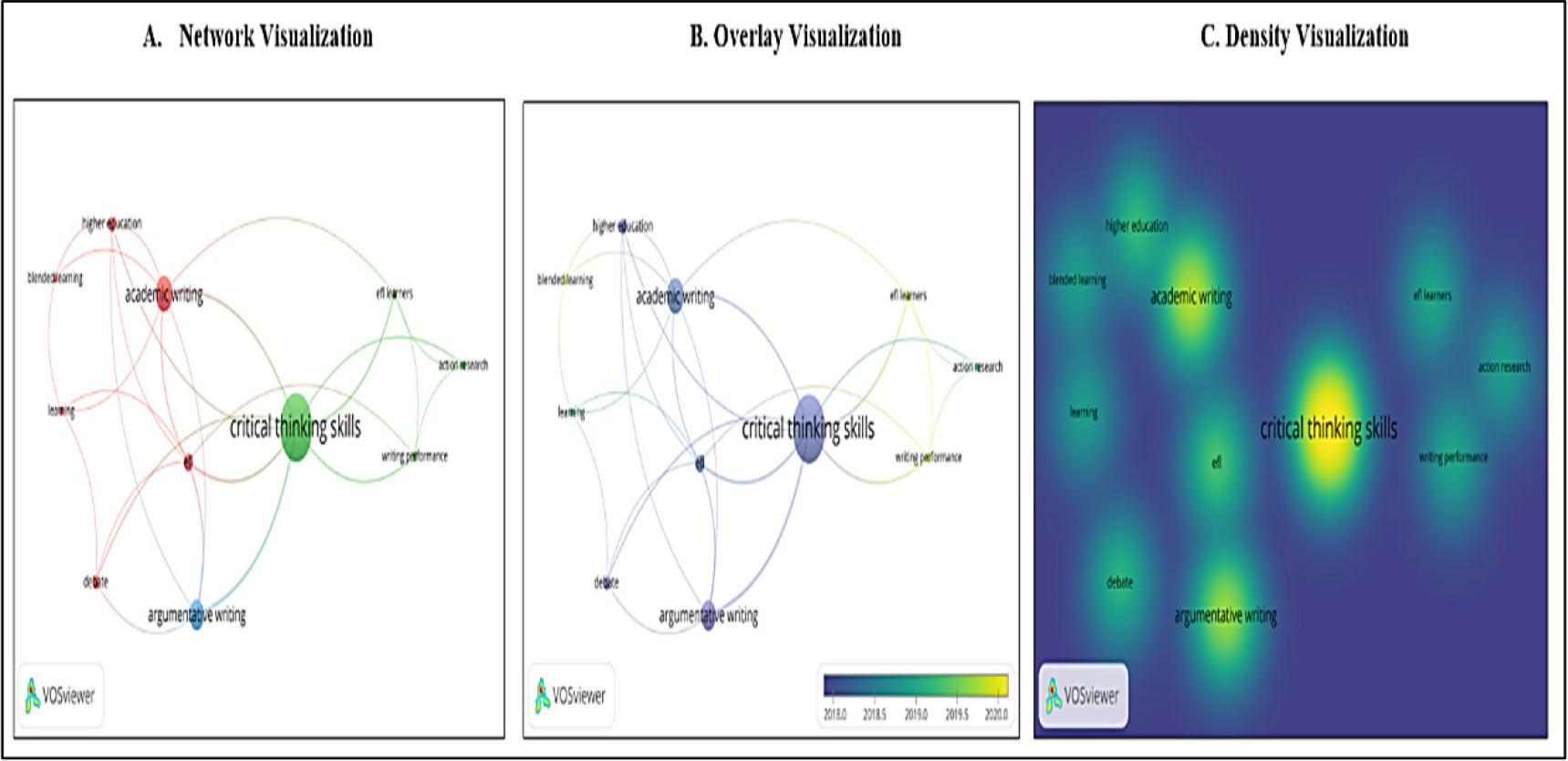
Figure 4:
Co-occurrence keywords.
Figure 4 depicts three types of visualization based on 11 elements, 3 clusters, and 27 linkages. The first of these is network visualization. To demonstrate the relationship, a network visualization of the author’s keywords is displayed. We chose author keywords from at least 5 articles. According to the full counting method, the findings revealed three clusters: author keywords of academic writing, EFL, and higher education in the first cluster; critical thinking skills, action research, and writing performance in the second cluster; and argumentative writing in the third. The second is overlay visualization. The publication timeframe is determined by the overlaying representation of the title and abstract, which ranges from 2018 to 2020. According to the overlay visualization, the findings indicated that critical thinking skills, argumentative writing, academic writing, and higher education are the top four author abstracts from the beginning of 2018 until the mid of 2018. Then learning and action research are the author keywords appear from the beginning of 2019 until the mid of 2019. While the author keywords of writing performance, EFL learners, and blended learning are trending in 2020. The last visualization is density in which critical thinking skills, argumentative writing, and academic writing are the top 3 author keywords at least have 5 occurrences.
Citations
Citations are the second type of analysis. It examines the average citation per year, the top cited publications, the intellectual structure in terms of co-citation network and historiography analysis, and the academic journals that publish works connected to critical thinking in argumentative texts between 1989 and 2021. The Biblioshiny software demonstrates that the average citation per year of critical thinking in argumentative texts articles from 1989 to 2021 is 0.9. Considering that, the average citations per year in 1992 and 1997 are 1.4 and 1.5, respectively. The year with the most typical citations throughout the year is 2011, with a score of 3.2, and the year with the lowest average citations per year is 2004, with a score of 2.9. Despite the fact that the average citation per year over the last ten years has been lower than the highest score, the trend is gradually increasing in relation to the average axis. Figure 5 depicts the overall outcome of yearly average article citations.
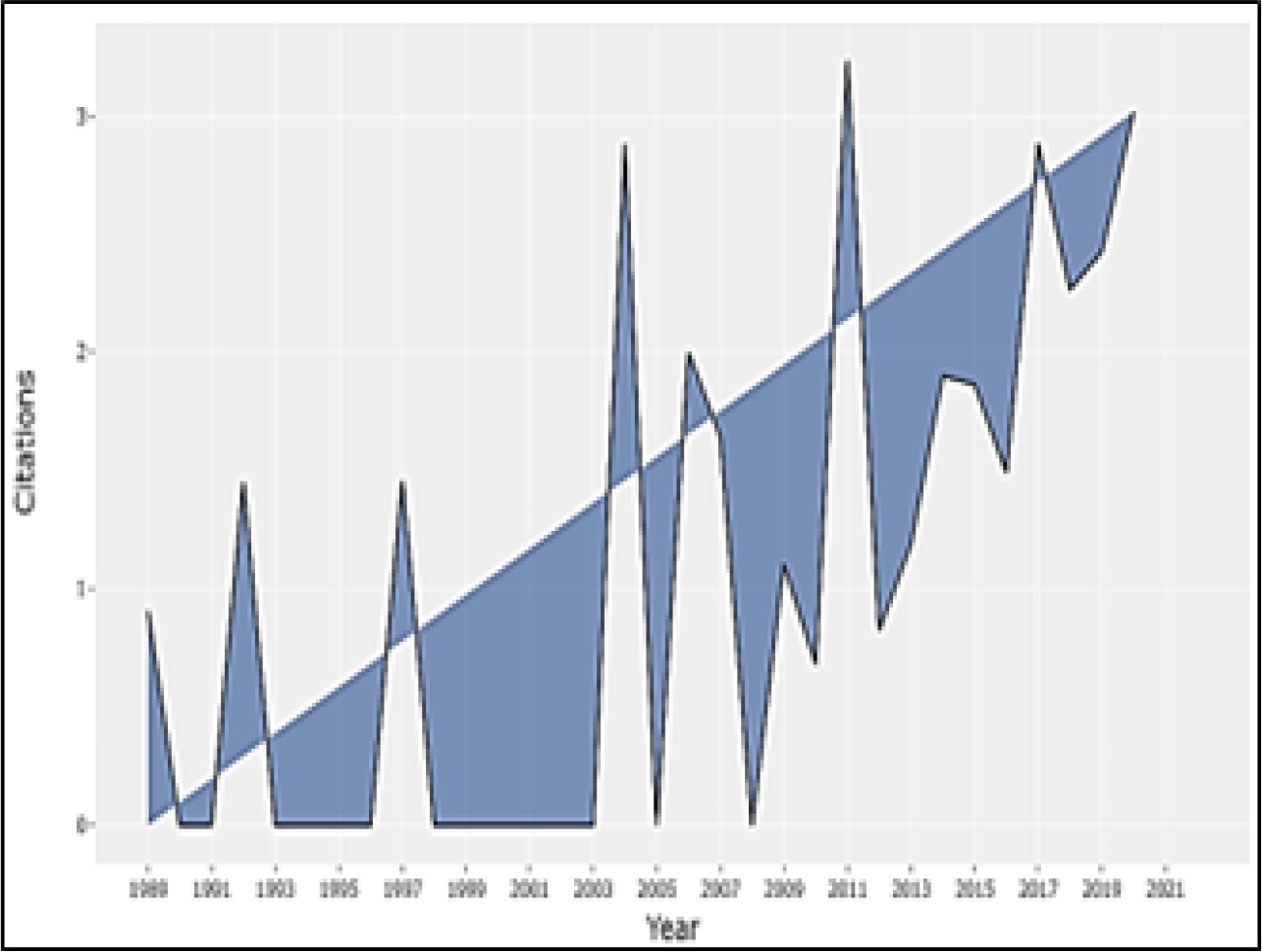
Figure 5:
Average article citations per year.
The identification of the most cited papers on critical thinking in argumentative writings from 1989 to 2021 was being explored further. Figure 6 depicts the most frequently cited publications according to the Biblioshiny analysis.
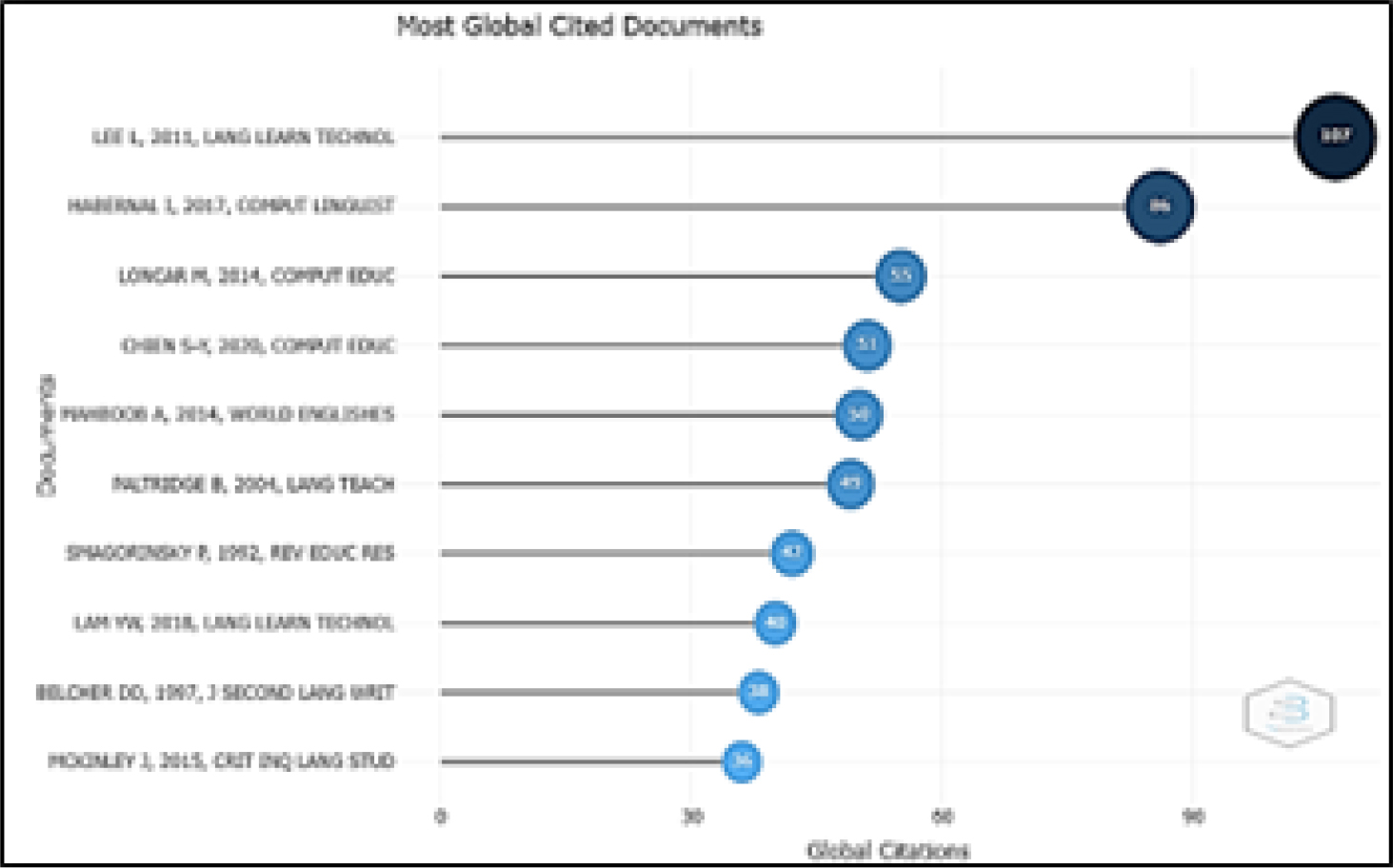
Figure 6:
The most cited articles.
Figure 6 shows that Lee L’s article, published in 2011, received 107 total citations. The second most cited article is Habernal I’s, which was published in 2017 and has been cited 86 times. Loncar M’s paper is ranked fourth, having been mentioned 55 times since its initial publication in 2014. Then, from 1989 to 2021, we used Biblioshiny software to investigate the conceptual analysis of structure in the context of co-citation network and historiography analysis of critical thinking in argumentative text articles. The intellectual design depicts the influence of a writer’s publications on a specific field of study. It depicts the links between units that serve as sources. According to Aria and Cuccurullo,[30] the evaluation of citations is a well-established method for identifying conceptual linkages. The co-citation examination is the most frequently employed scientometric approach for mapping a field’s conceptual structure and finding active research fields.[32] This relationship-building strategy is predicated on the notion that two texts regularly mentioned in subsequent articles will inevitably share comparable topics. As a result, the analysis of co-citations is an effective experimental approach for determining the intellectual structure and foundations of an idea.[33] Figure 7 depicts a reference co-citation analysis. The node’s size indicates the total amount of cites generated by the reference, and the thickness of the line connecting two nodes indicates the intensity of the co-citation.
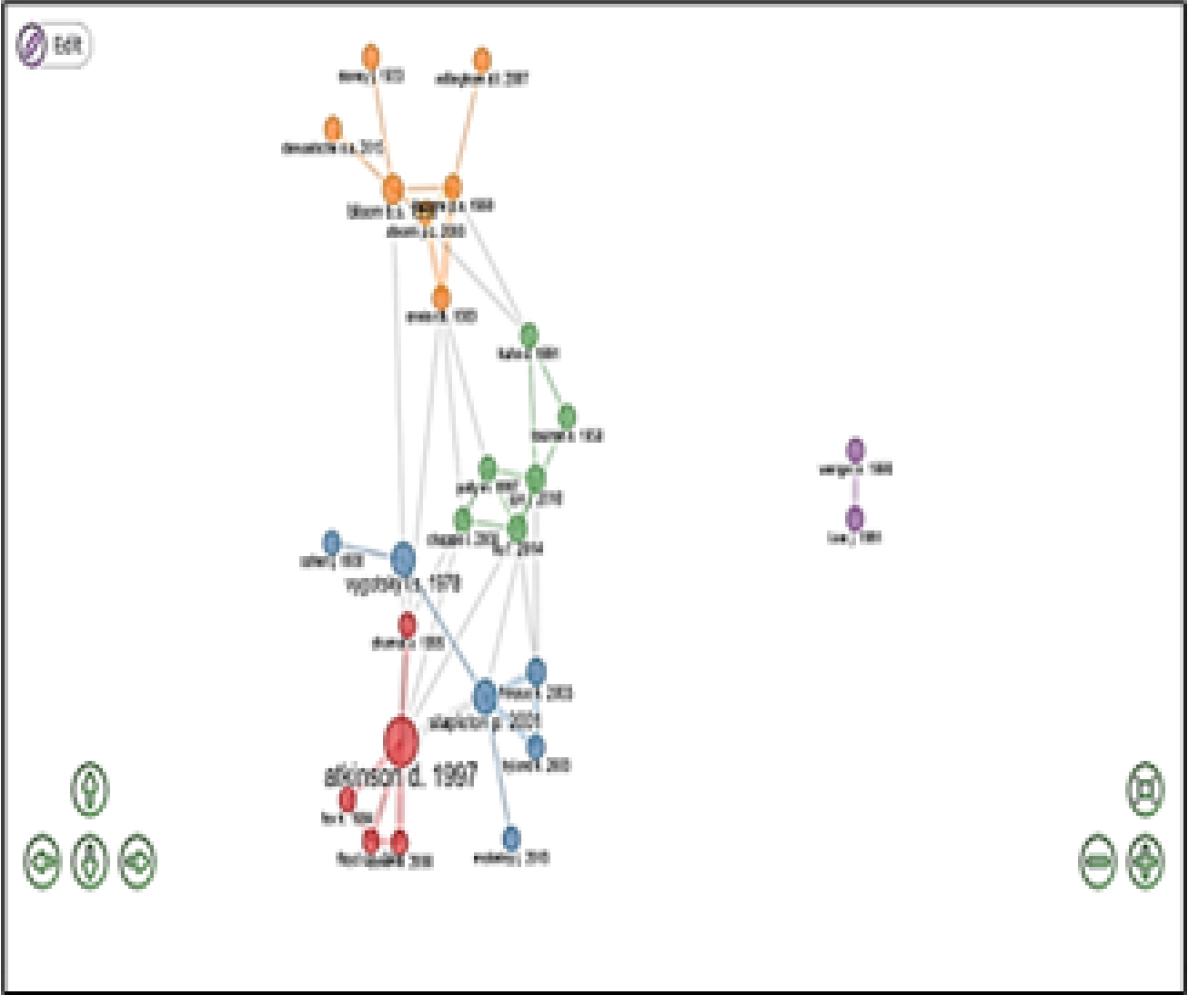
Figure 7:
Co-citation network.
As seen in Figure 7, the co-citation networks detected five clusters in five distinct hues. Papers in Cluster 1 (red) provide four reasons why TESOL teachers ought to be careful about implementing critical thinking instructions in their classes. (a) Critical thinking might be correlated more closely with an unspoken social norm than an established and understandable set of educational methods; (b) Critical thinking has frequently been condemned as exclusive and reductive; (c) Training thinking to non-native speakers may present social challenges, and (d) Thinking skills seem to fail to transmit properly once instructed outside of their specific circumstances of instruction.[34] Durkin’s[35] study appears to benefit from Atkinson’s paper.[34] She examines how East Asian students interact with Western educational standards in discussion and writing assignments. The study employs grounded theory and case study methods and takes a cultural approach. This is a new subject of study that presents a challenge to both British teachers and students. The second cluster (blue) is primarily concerned with a model for measuring L2 learners’ critical thinking in writing. (Stapleton, 2001). The study discovered that the eminence of critical thinking of L2 learners was dependent on the issue of material. Stapleton’s[36] study played an important part in Hirose’s[37] investigation of the link between L1 (Japanese) and L2 (English) writing. The third cluster (green) primarily investigates student performance, student perception, the impact of an instructional intervention in counter argumentation, and the impact of a writing prompt in argumentative writing.[38] Lave and Wenger[39] emphasize the necessity of revisiting and reformulating learning concepts in the fourth cluster (purple). Cluster 5 (orange) recognizes critical thinking as subject-specific, practical and theoretically valuable, and useful for educational assessment and instruction.[40,41]
The following analysis in the intellectual structure is historiography analysis. Figure 8 depicts the network that includes previous direct citations. It is a network of sequential natural sources linked to bibliographic data that detects and records the most remarkable articles on a specific topic year after year.[42] A historiography is built on direct citations and establishes intellectual connections in chronological sequence. The node at the center indicates the piece of paper cited by the other papers in the examined collection, the border denotes direct citation, and the axis that runs horizontally shows the publication years.[30] Each historical path (shown by a different color) corresponds to a research concept and its supporting documents as it is shown in Figure 8.

Figure 8:
Historical direct citation network.
Historical path (dark green) represents teaching and evaluation of critical appraisal skills,[43] later it was further continued by Wale[44] to investigate students’ critical thinking by using inquiry-based learning. The light brown line indicates the reading-to-writing process and written outcomes of both successful and unsuccessful EFL writers.[45] in which it was further investigated by Xu and Li.[46] Their research focuses on a process-genre strategy for learning proficient English as a Foreign Language (EFL) students’ writing for academic purposes skills. Then the path represented in light green describes the exploration pattern of both rhetorical functions and objects of enquiry in the writing prompts in high stakes test (TOEFL, IELTS, and TEM4). These findings imply that high-stakes exam prompts are converging around a limited number of themes, resulting in prescriptive responses that do not take into account the full variety of linguistic and argumentative options expected in academic writing[38] in which later Carrió-Pastor[47] further concluded that meta-discourse devices illustrate distinct modes of reasoning in essays written at various levels of English proficiency. The historical path (purple) focuses on the use of computer-aided argumentative essay mapping system,[48,49] the Tosca color focuses on the development and evaluation of a rubric used to evaluate students’ writing as well as an Electronic Peer Feedback (e-PF) system to promote reflective thinking.[50,51] The orange hue examines the connection that exists between writing and critical-thinking skills,[52] and how to teach students to analyze information critically by using easy-guided evaluation of online remarks.[53] The blue hue reflects the implementation of a mixed instructional method that includes the Thesis, Analysis, and Synthesis Key (TASK) procedural approach and the application of digital gaming components to students’ argumentative writing,[54] in which later it was further developed into online peer-assessment method to encourage mind-mapping flipped classrooms for university students’ English writing course[55,56] and pink color emphasizes the classification mapping of critical thinking abilities in EFL,[57] the use of explicit reasoning and exploratory talk for critical thinking development,[58] and critical thinking is interwoven in English course goals, language instruction tasks, tests, and teaching approaches for low-proficiency secondary EFL learners.[59]
Furthermore, the results of the identification of the academic journals publish articles related to critical thinking in argumentative texts from 1989 to 2021 is shown in Figure 9.
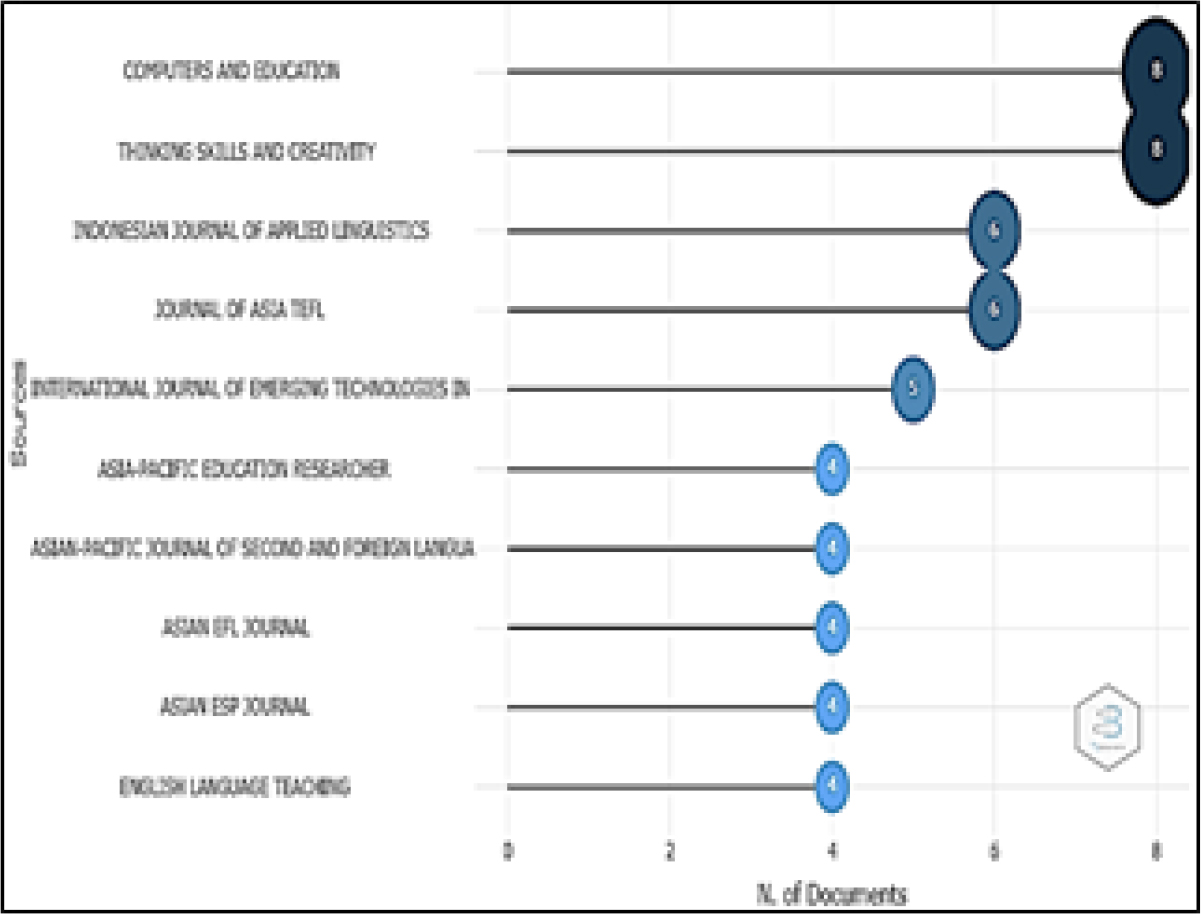
Figure 9:
The most relevant journals.
Figure 9 shows that both Computer and Education and Thinking Skills and Creativity journals have published each 8 articles. The second chart is placed by both Indonesian Journal of Applied Linguistics (IJAL) and Journal of Asia TEFL journals which have published each 6 articles. The only journal which has published 5 articles is International Journal of Emerging Technologies in Learning, while Asia-Pacific Education Researcher, Asian-Pacific Journal of Second and Foreign Language Education, Asian EFL Journal, Asian ESP Journal and English Language Teaching journals have issued each 4 articles.
Authorship
Regarding the authorship, we investigated the most productive authors, the highly-cited authors, the most impacting authors, the most productive affiliations, world map of the greatest industrious countries, the utmost fruitful nations, and co-authorship. The result from the Biblioshiny software on the most prolific authors of critical thinking in argumentative texts articles from 1989 to 2021 reveals that there are 585 authors contributed research focusing on critical thinking in argumentative texts. However, the top 10 prolific authors are alienated into two clusters. The first cluster is the authors who published each 3 documents. They are Hwang, G.J., Stapleton, P., and Sumarmi. The second group is the authors who published each 2 documents. They are Alias, N., Astina, I.K., Chien, S.Y., Clark, S.Y., Cridland-Hughes, S., and DeWitt, D. The details are illustrated in Figure 10.
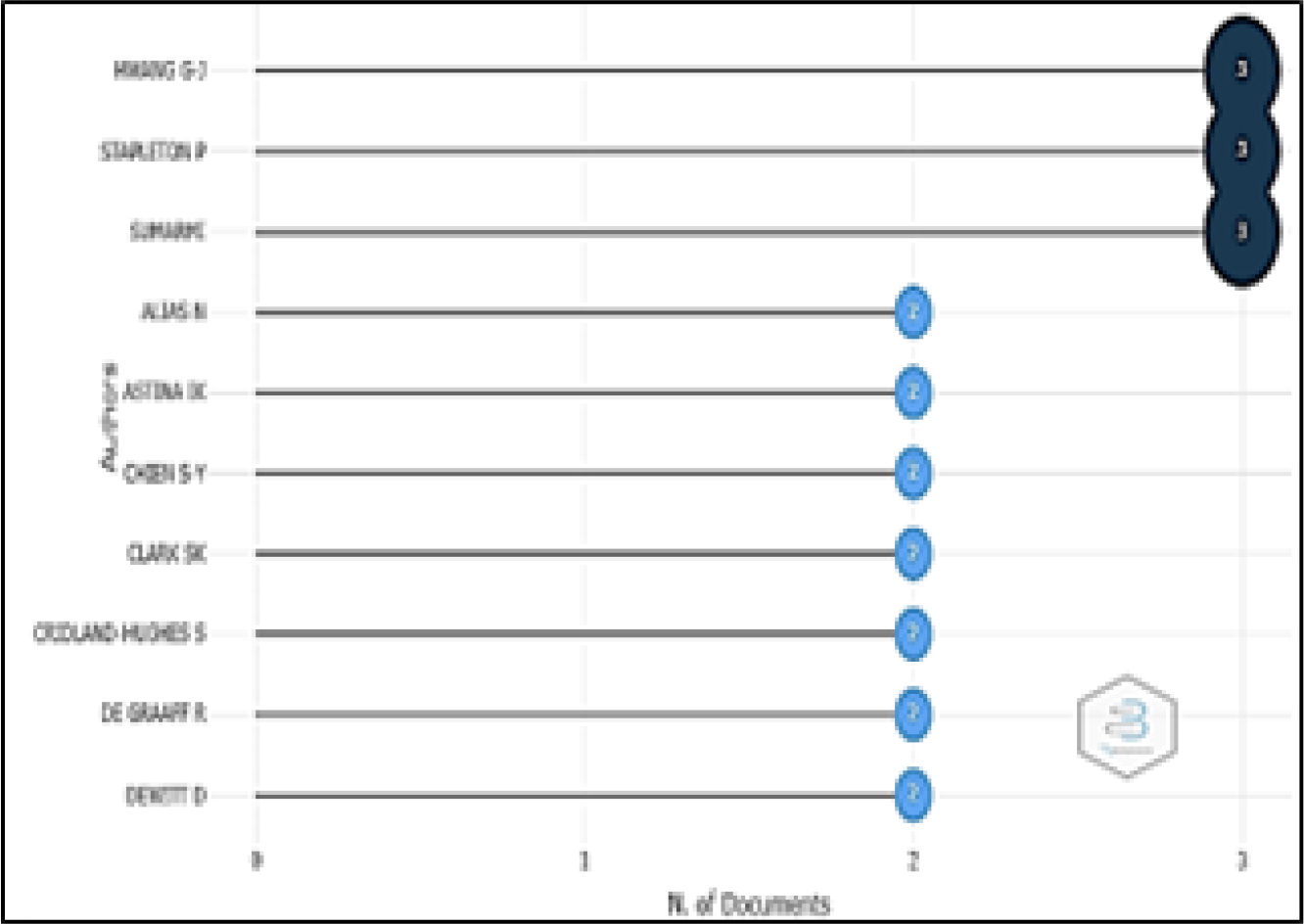
Figure 10:
The most prolific authors.
To unveil the most cited authors of critical thinking in argumentative texts articles from 1989 to 2021 we used the Biblioshiny software. The result on the most cited authors is shown in Figure 11.
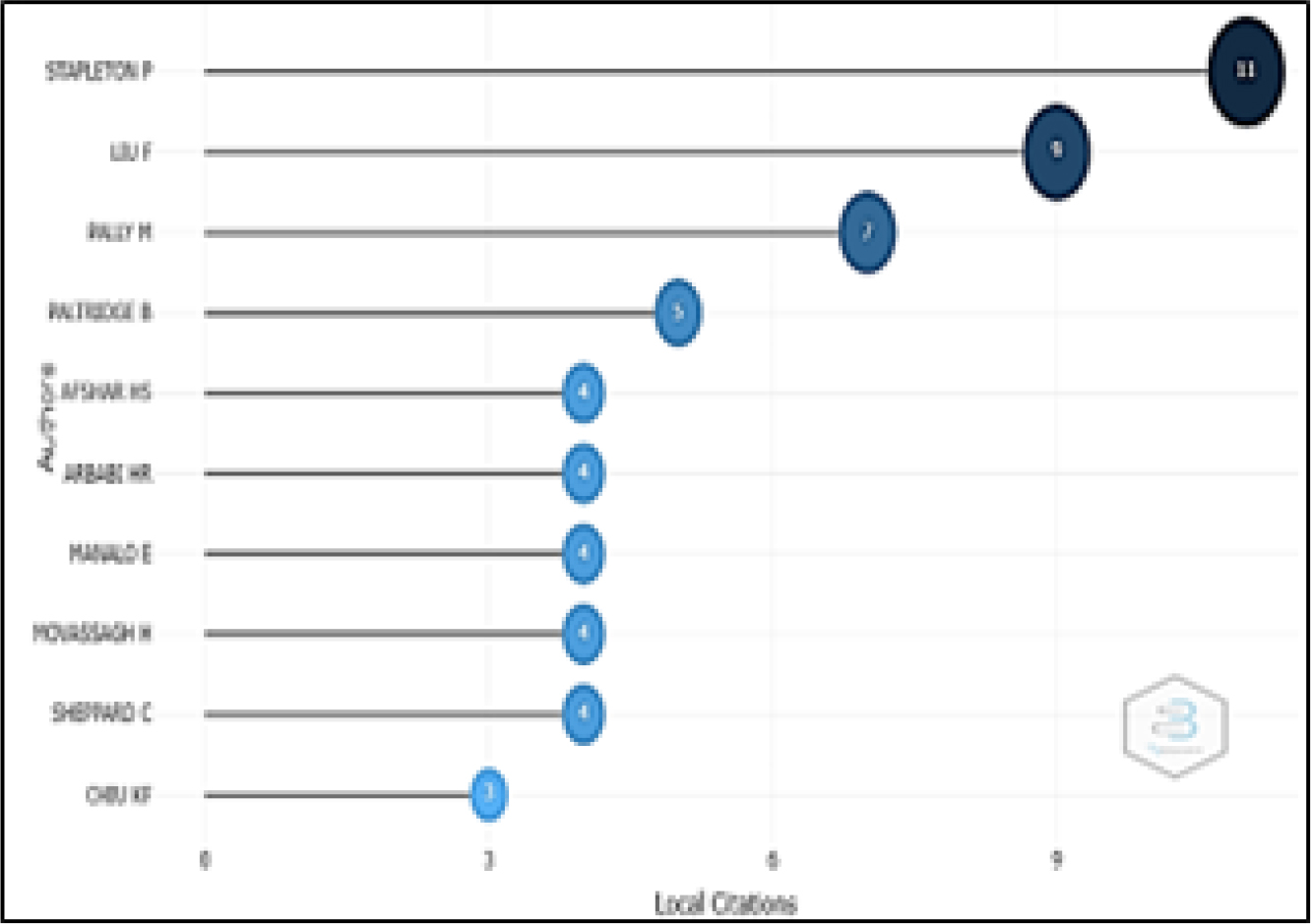
Figure 11:
The most cited authors.
Figure 11 shows that Stapleton is the most cited author with 11 total citations. The second highly cited author is Liu with 9 of the total citations. Then Pally and Paltridge published articles with total citations 7 and 5 respectively. The following authors are Afshar, Arbabi, Manalo, Movassagh, and Sheppard who share similar total citations, 4. At last, Chiu’s article was cited 3 times in Scopus database. Moreover, the result of the most impacting authors based on the total citation impact measures is shown in Figure 12.
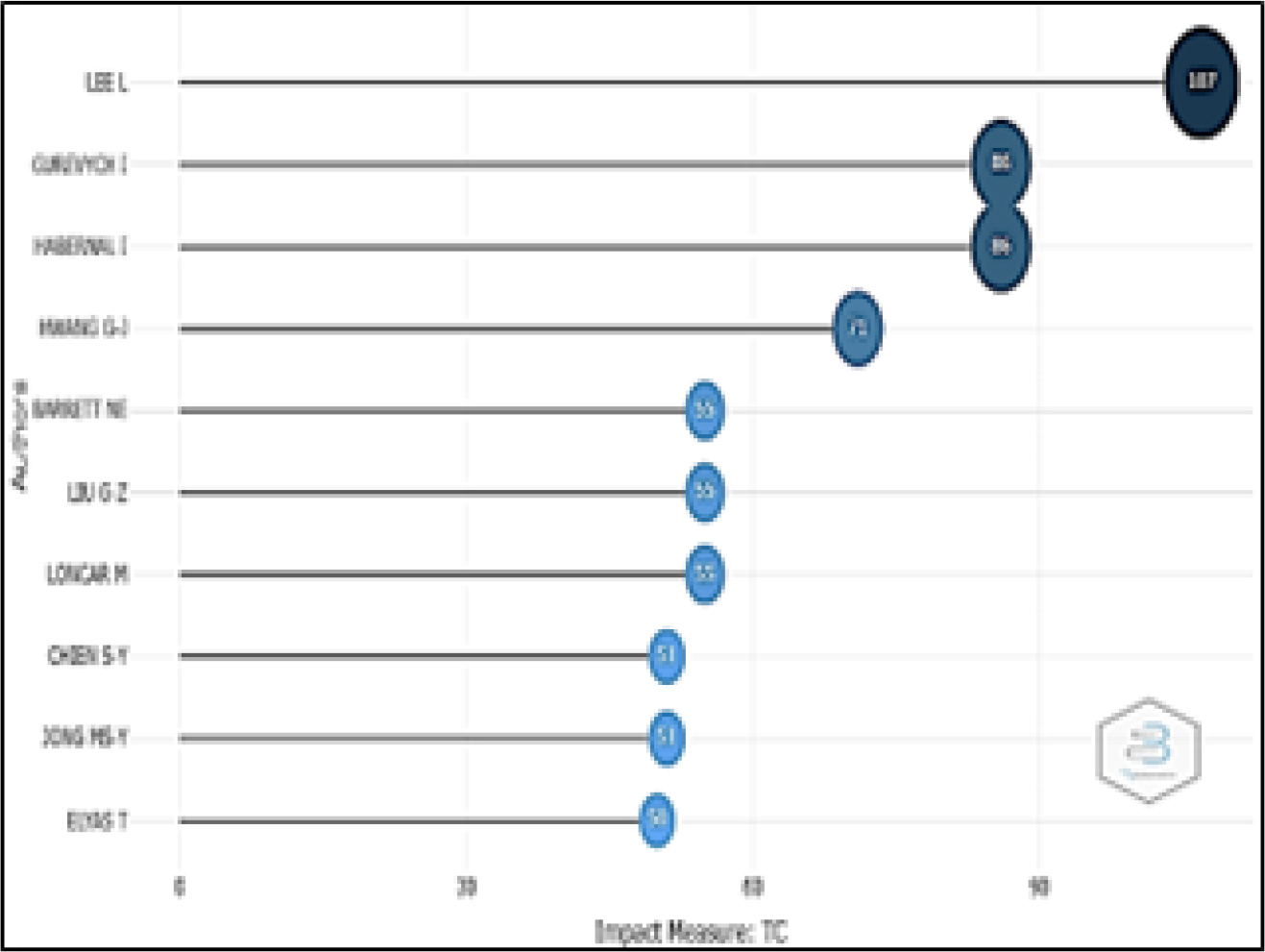
Figure 12:
The most impacting authors.
Figure 12 clearly shows that the most impacting author is Lee who has total citation 107, and then Gurevych and Habernal share similar amount of total citation, 86. The third most impacting author is Hwang who has 71 total citations. Afterward, Barrett, Liu, and Loncar are the trio authors who have similar total citation, 55. While Chen and Jong also have similar score of total citation, 51, which is followed by Elyas whose total citation is 50. Further, according to the data analysis from Biblioshiny, the detail of most productive affiliations is presented in Figure 13 published in the period from 2001-2010 is not written.
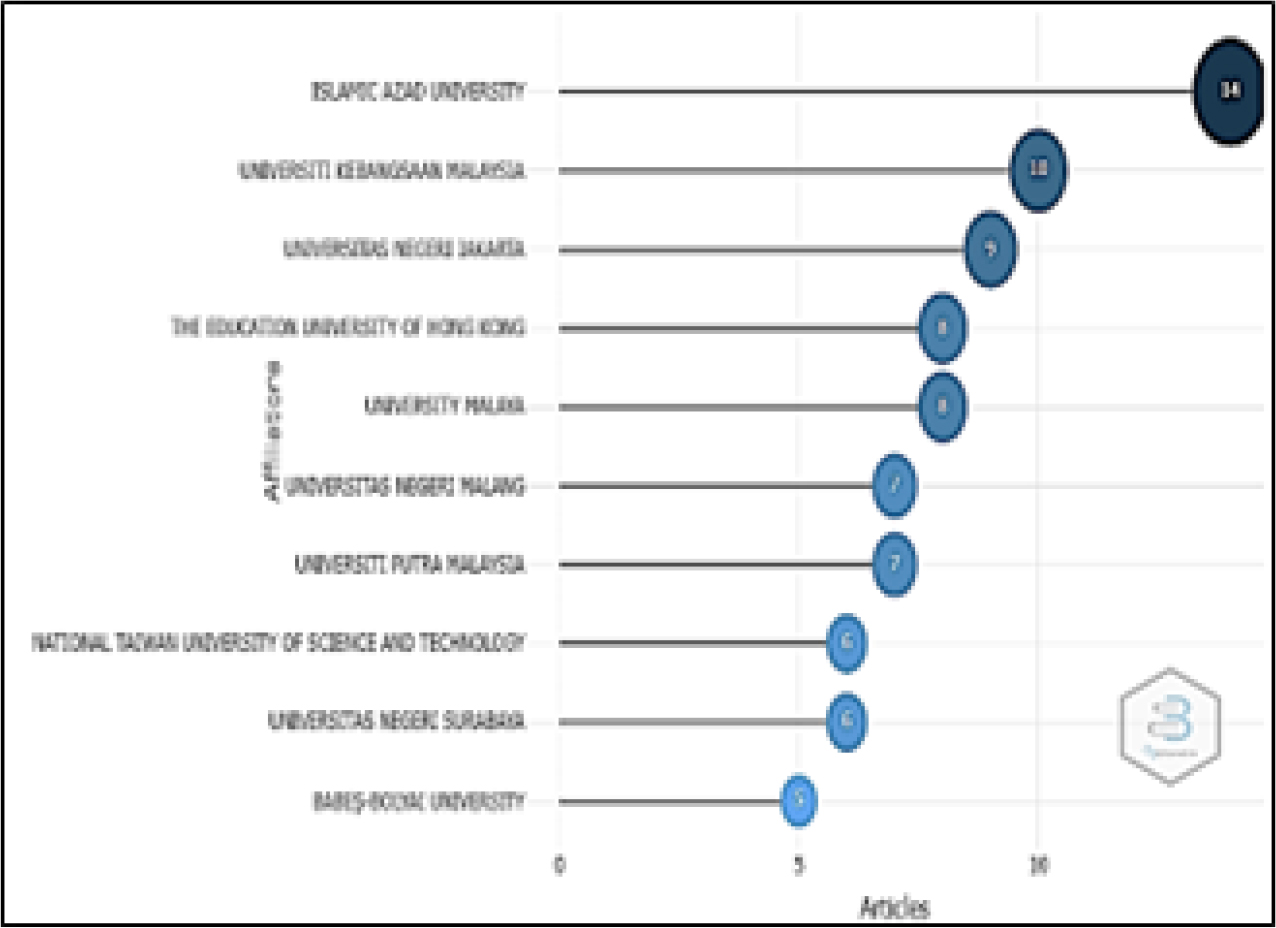
Figure 13:
The most impacting authors.
Based on the presented data in Figure 13, the most productive affiliation publishing critical thinking in argumentative texts articles from 1989 to 2021 is Islamic Azad University, The Islamic Republic of Iran. The Islamic Azad University has published 14 articles in Scopus. The second most productive affiliation is University Kebangsaan Malaysia, Malaysia which has published 10 articles. The third most productive affiliation is from Indonesia, Universitas Negeri Jakarta, which has published 9 articles in Scopus.
The following research objective is to investigate the most productive countries contributing critical thinking in argumentative texts articles from 1989 to 2021. Related to the collected data from Scopus database and analyzed using Biblioshiny software, the greatest industrious nations is shown in Figure 14.
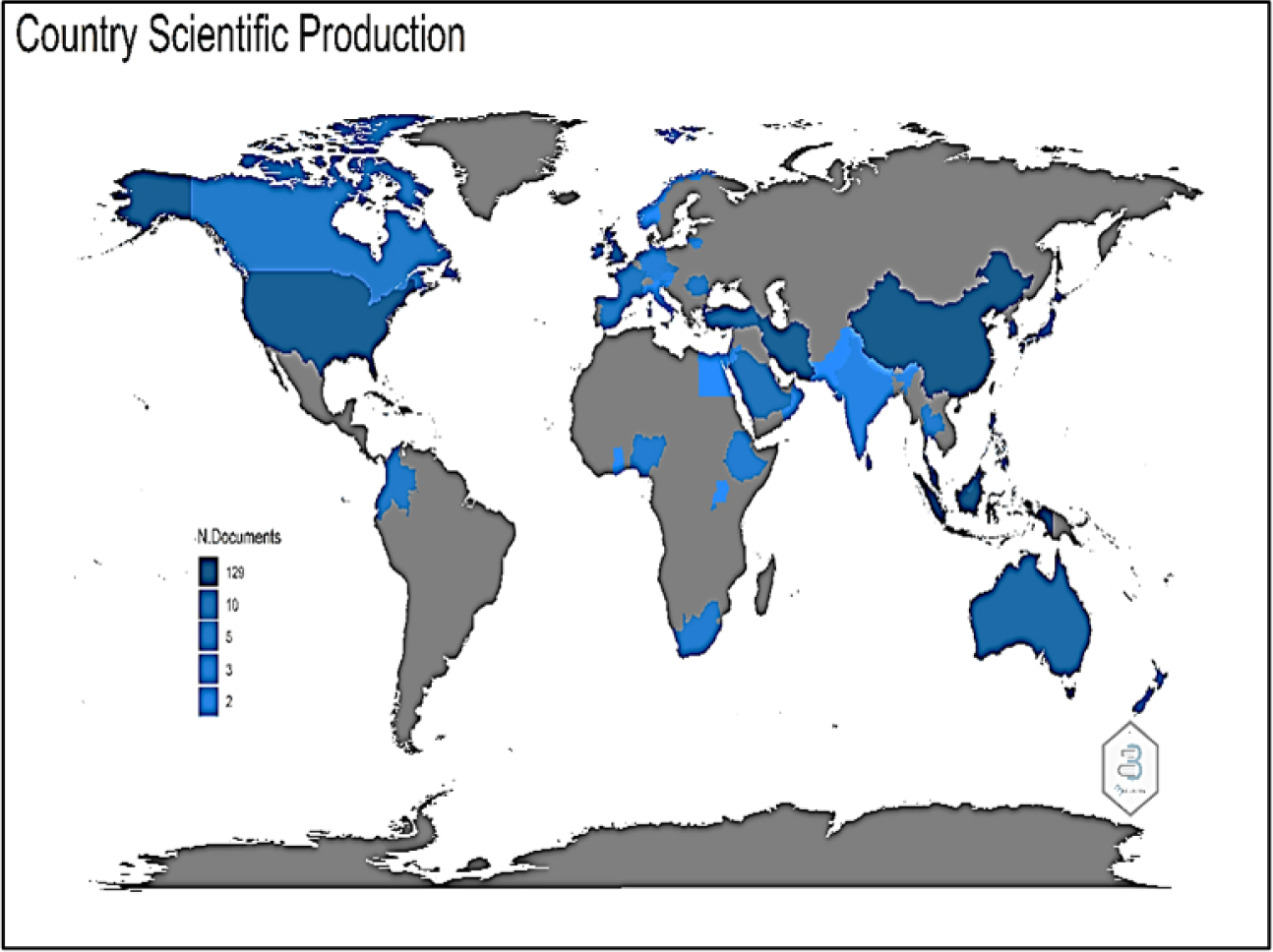
Figure 14:
World map of the most productive countries.
Based on the most productive countries’ World map in Figure 14, Indonesia, China, USA, Iran, Malaysia, Australia, Turkey, UK, and South Korea are the most productive country published articles contributing critical thinking in argumentative texts articles from 1989 to 2021 as their country map is dark blue. The dark blue color means the country published more articles in Scopus database compared to the light blue map countries like Saudi Arabia, Netherlands, Philippines, France, Israel, Japan, Canada, Colombia, Ecuador, Romania, and Spain. In detail, Figure 9 shows the total number of Scopus articles published based on countries.
Based on Figure 15, Indonesia is the most productive country with the total published articles on Scopus database is 129. The second most productive country is China with 103 total publication articles in Scopus. Even though the most productive affiliation is located in Iran, it does not address Iran as the most productive country. As it can be seen that Iran totally published 52 articles in Scopus database. The similar phenomenon occurs in Malaysia, in which the most affiliation does not represent Malaysia into top three the most productive country in which there are 46 articles published in Scopus database.

Figure 15:
The most productive countries.
At last, to investigate the co-authorships of critical thinking in argumentative texts articles from 1989 to 2021, we use VOSviewer software to analyze the data. We initially picked co-authorship as the kind of investigation and then “authors” as the topic of the inquiry. Then, there were 574 authors, and 39 met the criterion after we set the minimum number of keyword repetitions to (0). A relevancy score was assigned to every single of the 39 authors. The most pertinent phrases were chosen based on the score. It was found 39 authors. The detailed map and information related to the co-authorship of authors of critical thinking in argumentative texts is shown in Figure 16 below.
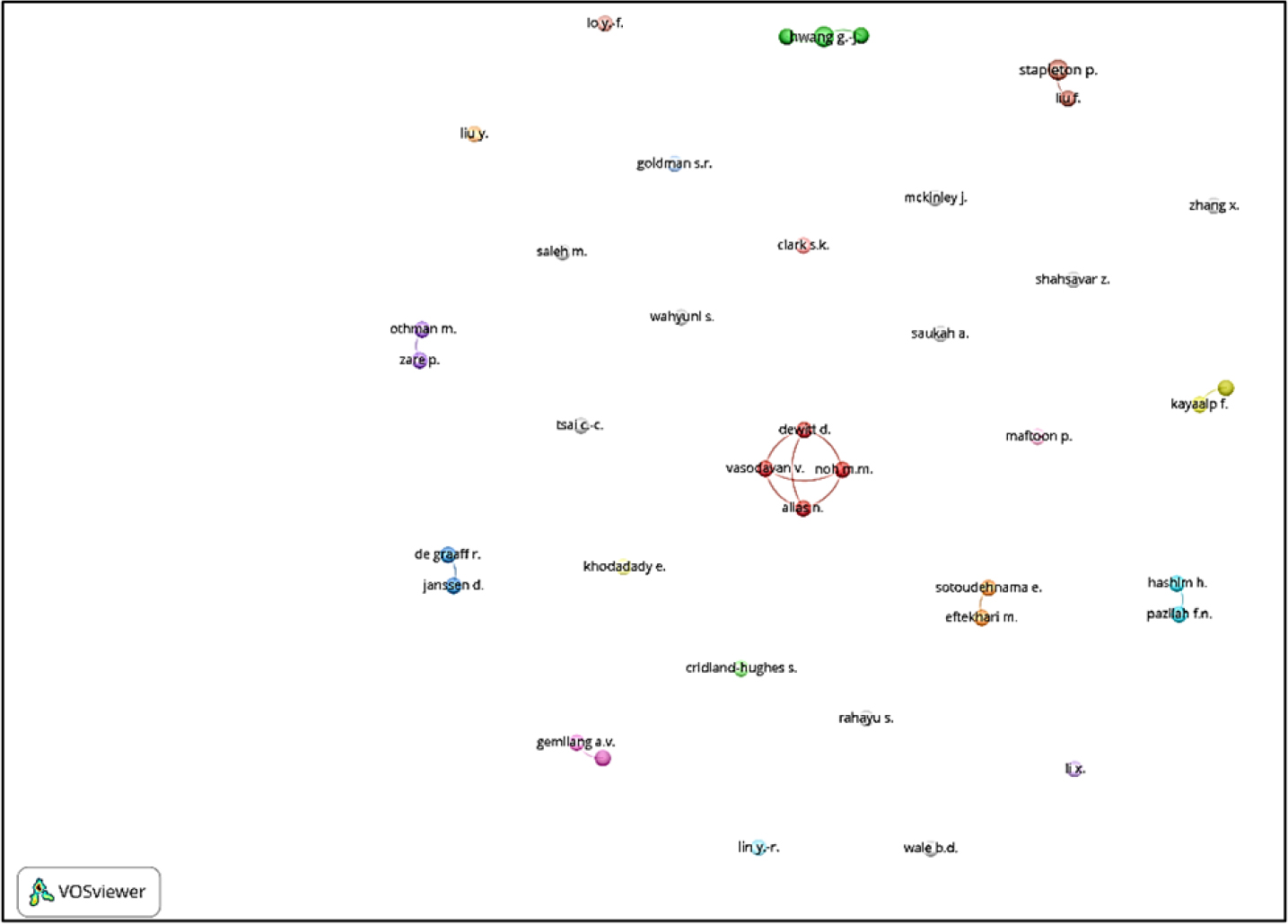
Figure 16:
Co-authorships.
Figure 16 shows that there are 39 items, 27 clusters, and 15 total links. The biggest cluster of co-authorships consists of 4 authors, they are Alias N., Dewitt D., Noh M.M., and Vasodavan V. This cluster has 3 links and the total link strength is 6. The second biggest cluster of co-authorships consists of 3 authors, they are Chien S., Hwang G., Lin C. This cluster has 2 links within total link strength 3.
DISCUSSION
In the current research, a topic-based bibliometric examination of critical thinking in argumentative texts topic spanning from 1989 to 2021 was settled to address above-mentioned study objectives. The general growth in the number of scientific publications over the last three decades reflects a rising interest in research focusing on critical thinking in argumentative texts. The interrelation among keywords, countries and affiliations reveal that Asia countries take the lead in conducting research focusing on critical thinking and argumentative writing in which the leading affiliations are also scattered across Asia. In regarding the average citation of critical thinking in argumentative texts articles, in spite of there was a decreasing average citations per year, the trend is gradually increasing related to the average axis.
In related to the most prolific authors, Asia scholars are leading in publishing research focusing on critical thinking in argumentative texts. He is Hwang G.J who is affiliated in National Taiwan University of Science and Technology, Taiwan. Here Hwang and Chen[60] employed inquiry-based ubiquitous gaming approach to improve students’ performance in on-the-job learning activities, including critical thinking and problem-solving. The study’s findings demonstrated that how learners think of their problem-solving and critical-thinking abilities was greatly improved. The most cited authors of critical-thinking in argumentative texts papers published in Scopus are Stapleton P., Liu F., Pally M., and Paltridge B. The high citation index of Stapleton and Liu could be due to their significant interest in how the wash-back impact of a high-stakes exam is correlated with students’ avoidance of counter-argumentation in their essays. The analysis of the most impacting authors of the field is based on the total citation index. The total citation here clearly shows how a certain author earns his/her reputation based on several published articles in Scopus. Here, Lee L is the most cited author in the area of critical thinking in argumentative texts published in Scopus database since 2011.
Regarding the most productive affiliations, it reveals that Asia universities are the top tiers conducting research of the field. It can be seen that Islamic Azad University, The Islamic Republic of Iran, ranks the first. The Islamic Azad University has published 14 articles in Scopus. The second most productive affiliation is University Kebangsaan Malaysia, Malaysia which has published 10 articles. The third most productive affiliation is from Indonesia, Universitas Negeri Jakarta, which has published 9 articles in Scopus. The publication of critical thinking in argumentative texts articles are spanned across the globe. There are 47 countries in which Indonesia is the most productive nation tailed by China, USA, Iran, Malaysia and Australia. This can be asserted that Asia countries dominated the publication of critical thinking in argumentative texts from 1989 to 2021. Even though Asia countries dominated in term of publication, however the most cited articles are not affiliated in Asia countries. Figure 10 shows that Lee L’s article, published in 2011, got 107 total citations. The second most cited article is Habernal I’s, published in 2017, which has been cited 86 times. Loncar M’s work ranks fourth, having been mentioned 55 times since it was first published in 2014.
The intellectual framework explains the impact of an author’s work on a certain field of research. Co-citation research and historiography analysis are included in this academic structure. The co-citation networks revealed five categories, each of which was colored differently. Papers in Cluster 1 (red) explain why TESOL teachers should be careful about implementing critical thinking approaches in their lessons. The second cluster (blue) mainly focuses on a model for assessing critical thinking in writing of L2 learners.[36] The third cluster (green) mainly focuses on the investigation of students’ performance, students’ perception, the impact of a writing prompt in argumentative writing and the effect of a teaching strategy in countering argumentation.[61] The fourth cluster (purple), Lave and Wenger[39] predominantly emphases on the prominence of rethinking and reformulation of learning conception. Cluster 5 (orange) recognizes critical thinking as specific to the topic, practical and theoretically valuable, and useful as a declaration of professional judgment in educational evaluation and instruction.[40,41]
The following analysis in the intellectual structure is historiography analysis. Figure 12 visualizes the historical direct citation network. Each historical path (shown by a different color) corresponds to a study concept and its supporting documents as it is shown in Figure 12. It starts from dark green colors represents the concept of teaching and evaluation of critical appraisal skills[43] in which later it was further continued by Wale[44] to investigate students’ critical thinking by using inquiry-based learning. The light brown path that follows identifies the reading-to-writing process and written outputs of both effective and ineffective EFL writers,[45] in which it was further investigated by Xu and Li.[46] Then the path represented in light green describes the exploration pattern of both linguistic functions and objects of investigation in the writing stimuli in high stakes test (TOEFL, IELTS, and TEM4)[38] in which later Carrió-Pastor[47] further concluded that meta-discourse devices illustrate distinct modes of reasoning in essays written at various levels of English proficiency. The historical path (purple) focuses on the use of computer-aided argumentative essay mapping system,[48,49] the tosca color focuses on the formulation and evaluation of a rubric for evaluating students’ writing as well as an Electronic Peer Feedback (e-PF) system to promote reflective thinking.[50,51] The orange color discusses the correlation between writing and critical thinking skills[52] and the implementation of brief, directed critiques of online discussions facilitates students to think critically.[53] The blue hue reflects the implementation of a mixed learning technique incorporating the Thesis, Analysis, and Synthesis Key (TASK) operational approach, as well as the usage of digital game components on students’ argumentative writing,[54] in which later it was expanded into an online peer evaluation system to enable mind-mapping flipped classrooms for university English writing courses[55,56] and pink color highlights the classification map of critical thinking skill in EFL,[57] the application of overt reasoning and exploratory discussions for critical thinking development,[58] and the embedded of critical thinking to the English lesson objectives, language learning instructions, tasks, and teacher attitude for low proficiency secondary EFL learners.[59]
The topic argument mapping was in trend in 2017 and followed by academic writing topic in 2018. While in 2019, the trends topic are shifting into: writing performance, English writing, English language, and critical thinking. Unlike the trends topic in 2017, 2018, and 2019, the trends topic in 2020 are moving into: writing skills, argumentative writing, thinking skills, and EFL students/learners. Referring to the most published academic journals, Computer and Education and Thinking Skills and Creativity journals ranks first in which each of it published 8 articles, and it is followed by Indonesian Journal of Applied Linguistics (IJAL) and Journal of Asia TEFL journals which have published each 6 articles. The only journal which has published 5 articles is International Journal of Emerging Technologies in Learning, while Asia-Pacific Education Researcher, Asian-Pacific Journal of Second and Foreign Language Education, Asian EFL Journal, Asian ESP Journal and English Language Teaching journals have published each 4 articles.
We also employed VOSviewer software to seek the co-occurrence of keywords and to investigate co-authorships of critical thinking in argumentative texts articles from 1989 to 2021. Form the VOSviewer analysis, there are three maps of visualization. The first is network visualization, and it indicated that there are 3 clusters in which author keywords of academic writing, EFL, and higher education grouped in the first cluster; critical thinking skills, action research and writing performance are grouped in the second cluster; argumentative writing is grouped in the third cluster. The second map visualization is overlay visualization. The publication time frame is determined by the overlapping picture of the title and abstract, which ranges from 2018 to 2020. According to the overlay visualization, the findings indicated that critical thinking skills, argumentative writing, academic writing, and higher education are the top four author abstracts from the beginning of 2018 until the mid of 2018. Then learning and action research are the author keywords appear from the beginning of 2019 until the mid of 2019. While the author keywords of writing performance, EFL learners, and blended learning are trending in 2020. The last visualization is density in which critical thinking skills, argumentative writing, and academic writing are the top 3 author keywords at least have 5 occurrences. At last, to investigate the co-authorships of critical thinking in argumentative texts articles from 1989 to 2021. From Figure 16 it is revealed that the biggest cluster of co-authorships, consisting of 4 authors, Alias N., Dewitt D., Noh M.M., and Vasodavan V. This cluster has 3 links and the total link strength is 6. The second biggest cluster of co-authorships consists of 3 authors, they are Chien S., Hwang G., Lin C. This cluster has 2 links within total link strength 3.
CONCLUSION
This study aims to provide an in-depth assessment of scientific publications on innovative educational settings across time using bibliometric analysis. This current study looked into the themes of critical thinking in argumentative texts in terms of annual scientific journal, the three-field plot based on keywords-countries-and field affiliations, the average articles citation per year, recognized prolific scholars, the highest influencing authors, investigated the best-performing affiliations, nations the top cited articles, the intellectual structure in terms of co-citation network, and historiography analysis. A total of 257 documents were retrieved from Scopus database for this research published from 1989 to 2021. This paper provides several significant enhancements to the research body. First, the research revealed that the first paper on critical thinking was published in 1989, which might be the pioneer of the field of critical thinking. Based on historiographical analysis, it is found pertinent publication venues. The study identifies “critical thinking in argumentative writings” as the primary source of publishing. This finding serves as a significant guidance for researchers in determining the most appropriate publishing platform for their research articles.
Cite this article:
Suhartoyo E, Afrilyasanti R, Syahid A, Basthomi Y, Mukminatien N. Portraying Gaps and Trends in Critical Thinking Tendencies in Academic Writings for Future Research Directions: A Bibliometric Study from 1989 to 2021. J Scientometric Res. 2025;14(2):645-661.
References
- Dominey PF. Towards a construction-based framework for development of language, event perception and social cognition: insights from grounded robotics and simulation. Neurocomputing. 2007;70(13-15):2288-302. [CrossRef] | [Google Scholar]
- Hellendoorn A, Wijnroks L, van Daalen E, Dietz C, Buitelaar JK, Leseman P, et al. Motor functioning, exploration, visuospatial cognition and language development in preschool children with autism.. Res Dev Disabil.. 2015;39:32-42. [PubMed] | [CrossRef] | [Google Scholar]
- Nip IS, Green JR, Marx DB. The co-emergence of cognition, language, and speech motor control in early development: A longitudinal correlation study.. J Commun Disord.. 2011;44(2):149-60. [PubMed] | [CrossRef] | [Google Scholar]
- Yanchar SC, Slife BD. Teaching critical thinking by examining assumptions.. Teach Psychol.. 2004;31(2):85-90. [CrossRef] | [Google Scholar]
- Johnson DK. [Aug 1, 2022];CRITO: informal logic, critical thinking, and the argumentative essay. 1995 [CrossRef] | [Google Scholar]
- Lima C. Selecting literary texts for language learning. J NELTA. 1970;15(1-2):110-3. [CrossRef] | [Google Scholar]
- Unrau NJ. [Aug 2, 2022];The effects of explicit instruction on critical reading and argumentative writing: the task of reading and writing. 1991 [CrossRef] | [Google Scholar]
- Jones RP. [Aug 1, 2022];Foundations of critical thinking. 2000 [CrossRef] | [Google Scholar]
- Kingsbury J. Teaching argument construction.. Informal Logic.. 2001;22(1) [CrossRef] | [Google Scholar]
- Özsoysal F, Balcıoğlu L. Suggestions for critical thinking and creative writing method through literary works in ELT/and notes on creating a book project. Explore science. Technol Innov. 2006;3(1) [CrossRef] | [Google Scholar]
- Zainuddin SZ. [Aug 3, 2023];Effects of training in the use of argumentative structures on ESL students’ argumentative writing ability. 2006 [CrossRef] | [Google Scholar]
- Budden L. Critical thinking skills. Developing Effective Analysis and Argument. Contemp Nurse. 2007;25(1-2):174 [CrossRef] | [Google Scholar]
- Elsegood S. Teaching critical thinking in an English for academic purposes program using a “claims and supports” approach. Teaching Critical Thinking in an English for Academic Purposes Program Using a “claims and Supports” Approach. 2007:1-10. [CrossRef] | [Google Scholar]
- Rex LA, Thomas EE, Engel S. Applying Toulmin: teaching logical reasoning and argumentative writing.. Engl J.. 2010;99(6):56-62. [CrossRef] | [Google Scholar]
- Abbas MF, Herdi H. Solving the students’ problems in writing argumentative essay through collaborative writing strategy.. Engl Rev J Engl Educ.. 2018;7(1):105 [CrossRef] | [Google Scholar]
- Apsari NP. Teacher’s way to foster critical thinking in the classroom (A case study of a senior high school in Bandung).. J Engl Educ.. 2016;4(1):51-72. [CrossRef] | [Google Scholar]
- Ka-kan-dee M, Kaur S. Teaching strategies used by Thai EFL lecturers to teach argumentative writing.. Procedia Soc Behav Sci.. 2015;208:143-56. [CrossRef] | [Google Scholar]
- Segundo Marcos RI, López Ferández V, Daza González MT, Phillips-Silver J. Promoting children’s creative thinking through reading and writing in a cooperative learning classroom. Thinking Skills Creativity. 2019;36:100663 [CrossRef] | [Google Scholar]
- Setyowati L, Sukmawa S, Latief MA. Solving the students’ problems in writing argumentative essay through the provision of planning.. J Cult Engl Lang Teach Lit.. 2017;17(1) [CrossRef] | [Google Scholar]
- Syamsuri AS, Muhsin MA, Nurmayani N. The effectiveness of caricature media in learning writing of argumentation paragraph.. Theor Pract Lang Stud.. 2016;6(11):2079-86. [CrossRef] | [Google Scholar]
- Widyastuti S. Fostering critical thinking skills through argumentative writing.. Cakrawala Pendidikan.. 2018;37(2):182-9. [CrossRef] | [Google Scholar]
- van Eck NJ, Waltman L. Software survey: VOSviewer, a computer program for bibliometric mapping.. Scientometrics.. 2010;84(2):523-38. [PubMed] | [CrossRef] | [Google Scholar]
- Akintunde TY, Musa TH, Musa HH, Musa IH, Chen S, Ibrahim E, et al. Bibliometric analysis of global scientific literature on effects of COVID-19 pandemic on mental health. Asian J Psychiatry. 2021;63:102753 [PubMed] | [CrossRef] | [Google Scholar]
- Arici F, Yildirim P, Caliklar Ş, Yilmaz RM. Research trends in the use of augmented reality in science education: content and bibliometric mapping analysis. Comput Educ. 2019;142:103647 [CrossRef] | [Google Scholar]
- Hao T, Chen X, Song Y. A Topic-based bibliometric analysis of two decades of research on the application of technology in classroom dialogue.. J Educ Comput Res.. 2020;58(7):1311-41. [CrossRef] | [Google Scholar]
- Song Y, Chen X, Hao T, Liu Z, Lan Z. Exploring two decades of research on classroom dialogue by using bibliometric analysis. Comput Educ. 2019;137:12-31. [CrossRef] | [Google Scholar]
- Chan ZC. A systematic review of critical thinking in nursing education.. Nurse Educ Today.. 2013;33(3):236-40. [PubMed] | [CrossRef] | [Google Scholar]
- Noroozi O, Dehghanzadeh H, Talaee E. A systematic review on the impacts of game-based learning on argumentation skills. Entertainment Comput. 2020:35 [CrossRef] | [Google Scholar]
- Nwosu LI, Vorster H. A Systematic literature review on critical thinking in an undergraduate accounting programme.. Int J Financ Res.. 2021;12(4):225 [CrossRef] | [Google Scholar]
- Aria M, Cuccurullo C. Bibliometrix: an R-tool for comprehensive science mapping analysis.. J Inf.. 2017;11(4):959-75. [CrossRef] | [Google Scholar]
- Baas J, Schotten M, Plume A, Côté G, Karimi R. Scopus as a curated, high-quality bibliometric data source for academic research in quantitative science studies.. Quant Sci Stud.. 2020;1(1):377-86. [CrossRef] | [Google Scholar]
- Wei F, Zhang G. Exploring the intellectual structure and evolution of 24 top business journals: a scientometric analysis.. Electron Libr.. 2020;38(3):493-511. [CrossRef] | [Google Scholar]
- Benckendorff P, Zehrer A. A network analysis of tourism research.. Ann Tourism Res.. 2013;43:121-49. [CrossRef] | [Google Scholar]
- Atkinson D. A critical approach to critical thinking in TESOL.. TESOL Q.. 1997;31(1):71 [CrossRef] | [Google Scholar]
- Durkin K, Durkin K.. he middle way: East Asian master’s students’ perceptions of critical argumentation in U.K. universities. J Stud Int Educ.. 2008;12(1):38-55. [CrossRef] | [Google Scholar]
- Stapleton P. Assessing critical thinking in the writing of Japanese university students.. Written Communication.. 2001;18(4):506-48. [CrossRef] | [Google Scholar]
- Hirose K. Comparing L1 and L2 organizational patterns in the argumentative writing of Japanese EFL students.. J Second Lang Writing.. 2003;12(2):181-209. [CrossRef] | [Google Scholar]
- Liu F, Stapleton P. Writing prompt convergence in high-stakes tests: exploring rhetorical functions and objects of enquiry.. Stud Educ Eval.. 2015;47:68-75. [CrossRef] | [Google Scholar]
- Lave J, Wenger E. Situated learning: legitimate peripheral participation. 1991 [CrossRef] | [Google Scholar]
- Ennis RH. Critical thinking and subject specificity: clarification and needed research.. Educ Res.. 1989;18(3):4-10. [CrossRef] | [Google Scholar]
- Facione PA. The Delphi report. 1990;423(c):1-19. [CrossRef] | [Google Scholar]
- Garfield E. Historiographic mapping of knowledge domains literature.. J Inf Sci.. 2004;30(2):119-45. [CrossRef] | [Google Scholar]
- Melles G. Teaching and evaluation of critical appraisal skills to postgraduate ESL engineering students.. Innov Educ Teach Int.. 2009;46(2):161-70. [CrossRef] | [Google Scholar]
- Wale BD, Bishaw KS. Effects of using inquiry-based learning on EFL students’ critical thinking skills.. Asian Pac J Second Foreign Lang Educ.. 2020;5(1) [CrossRef] | [Google Scholar]
- Lo YF. An analysis of effective and less effective EFL writers’ processes and products for a reading-to-write task.. Electron J Foreign Lang Teach.. 2011;8(2):154-69. [CrossRef] | [Google Scholar]
- Xu X, Li X. Teaching academic writing through a process-genre approach: A pedagogical exploration of an EAP program in China.. TESL E J.. 2018;22(2):1-21. [CrossRef] | [Google Scholar]
- Carrió-Pastor ML. The assessment of metadiscourse devices in English as a foreign language. Assessing Writing. 2021:50 [CrossRef] | [Google Scholar]
- Chiang KH, Fan CY, Liu HH, Chen GD. Effects of a computer-assisted argument map learning strategy on sixth-grade students’ argumentative essay reading comprehension.. Multimedia Tool Appl.. 2016;75(16):9973-90. [CrossRef] | [Google Scholar]
- Uçar B, Demiraslan Çevik Y. The effect of argument mapping supported with peer feedback on pre-service teachers’ argumentation skills. J Digit Learn Teach Educ. 2021;37(1):6-29. [CrossRef] | [Google Scholar]
- Pham TN, Lin M, Trinh VQ, Bui LT. Electronic peer feedback, EFL academic writing and reflective thinking: evidence from a Confucian context.. Sage Open.. 2020;10(1) [CrossRef] | [Google Scholar]
- Rakedzon T, Baram-Tsabari A. To make a long story short: A rubric for assessing graduate students’ academic and popular science writing skills. Assessing Writing. 2017;32:28-42. [CrossRef] | [Google Scholar]
- Soodmand Afshar HS, Movassagh H, Radi Arbabi H. The interrelationship among critical thinking, writing an argumentative essay in an L2 and their subskills. Lang Learn J. 2017;45(4):419-33. [CrossRef] | [Google Scholar]
- Allagui B. TED talk comments to enhance critical thinking skills in an undergraduate reading and writing course.. Educ Inf Technol.. 2021;26(3):2941-60. [CrossRef] | [Google Scholar]
- Lam YW. Improving argumentative writing: effects of a blended learning approach and gamification.. Lang Learn Technol.. 2018;22(1):97-118. [CrossRef] | [Google Scholar]
- Fu QK, Lin CJ, Hwang GJ, Zhang L. Impacts of a mind mapping-based contextual gaming approach on EFL students’ writing performance, learning perceptions and generative uses in an English course.. Comput Educ.. 2018;137:59-77. [CrossRef] | [Google Scholar]
- Lin CJ. J Comput Educ.. 2019;6(3):385-415. [CrossRef] | [Google Scholar]
- Li X, Liu J. Mapping the taxonomy of critical thinking ability in EFL. Thinking Skills Creativity. 2021;41:100880 [CrossRef] | [Google Scholar]
- Liang W, Fung D. Fostering critical thinking in English-as-a-second-language classrooms: challenges and opportunities.. Thinking Skills Creativity.. 2021;39:100769 [CrossRef] | [Google Scholar]
- Bağ HK, Gürsoy E. The effect of critical thinking embedded English course design to the improvement of critical thinking skills of secondary school learners✰. Thinking Skills Creativity. 2021:41 [CrossRef] | [Google Scholar]
- Hwang GJ, Chen CH. Influences of an inquiry-based ubiquitous gaming design on students’ learning achievements, motivation, behavioral patterns, and tendency towards critical thinking and problem solving.. Brit J Educational Tech.. 2017;48(4):950-71. [CrossRef] | [Google Scholar]
- Liu F, Stapleton P. Counterargumentation and the cultivation of critical thinking in argumentative writing: investigating washback from a high-stakes test.. System.. 2014;45(1):117-28. [CrossRef] | [Google Scholar]

